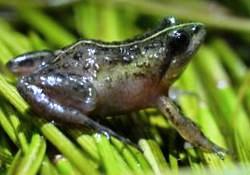Micro frog facts for kids
Quick facts for kids Micro frog |
|
|---|---|
 |
|
| Conservation status | |
| Scientific classification |
The micro frog (Microbatrachella capensis), also known as the Cape Flats frog, is a tiny frog from South Africa. It's super small, usually less than 2 cm (0.8 in) long! This makes it one of the smallest frogs in its region.
Micro frogs can be different colors, like reddish-brown with dark spots, or even tan or green. Their color depends on where they live. These special frogs are found only in the south-western Cape area of South Africa. They live in wet areas called wetlands, especially in a unique plant community called fynbos. Sadly, the micro frog is "critically endangered", which means it's at a very high risk of disappearing forever.
Contents
What Does the Micro Frog Look Like?
The micro frog is a really small frog with a rounded nose and smooth skin. It grows to about 18 mm (0.71 in) long. Its back is dark brown with tiny pale brown spots. There's also a light-colored stripe running down each side of its body.
You might notice a dark line between its eyes and a thin pale line along its spine. The frog's underside is light brown, and its belly has white spots.
Where Do Micro Frogs Live?
Micro frogs are found only in the south-western Cape area of South Africa. You can find one group on the Cape Flats in Cape Town. Other groups live on the eastern side of False Bay, stretching from Kogelberg to Cape Agulhas.
These frogs prefer to live in low-lying areas. Their natural home is in and around shallow, watery wetlands. These wetlands are often found within coastal fynbos, which is a special type of plant community. Fynbos is like a Mediterranean-style bushland with many unique plants, including restios (Cape reed). The wetlands they live in usually have some water all year round. Other parts get flooded during the rainy season, which is in winter and spring.
How Do Micro Frogs Live and Reproduce?
Micro frogs make their homes in wetlands that have sandy soil and coastal fynbos plants. They like areas with water seeping out of the ground and temporary pools that appear after rain. They need dark, slightly acidic water for their babies to grow.
The breeding season for micro frogs starts when the rainy season arrives, usually between July and September. The female frog lays her eggs, attaching them to plants in the water. The baby frogs, called tadpoles, grow slowly. When the dry season comes, these clever frogs dig themselves into the ground. They stay buried and sleep through the dry period, a process called aestivation, until the rains return.
Why Are Micro Frogs Endangered?
The micro frog's home is very small, covering only about 7 km2 (2.7 sq mi) in total. Their living areas are also broken up into many small pieces. The wetlands where they live are being damaged. The biggest threat is that their habitat is being drained to build things along the coast.
Because of these problems, the International Union for Conservation of Nature has listed the micro frog as "critically endangered". This means it's very important to protect these tiny frogs and their homes so they don't disappear forever.


